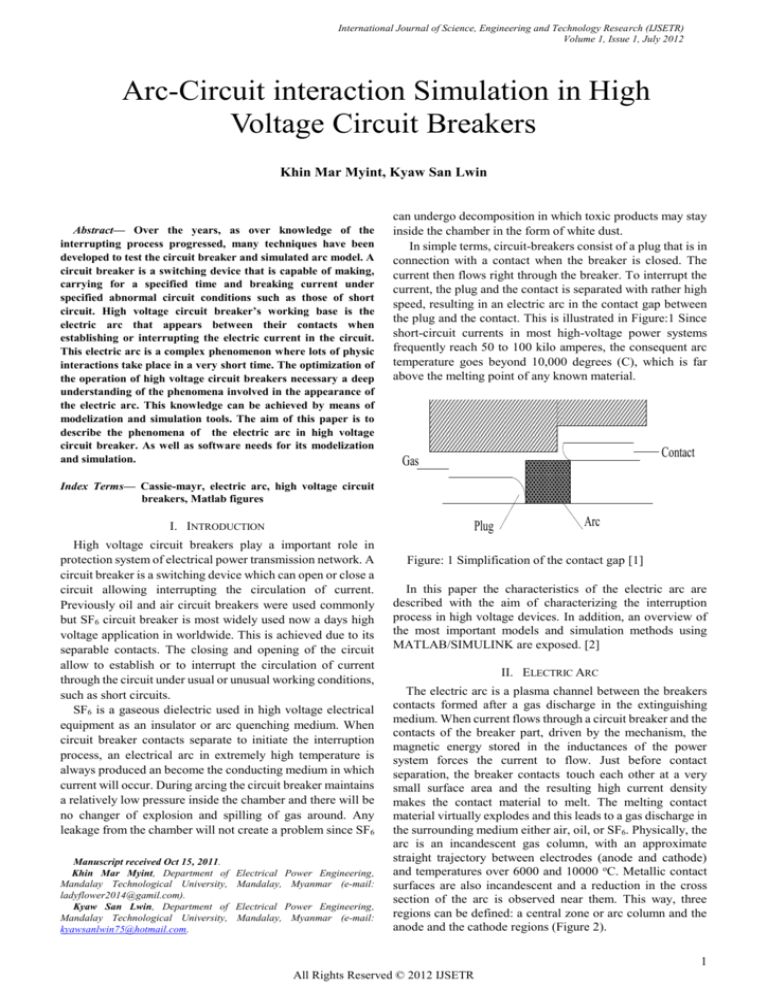
International Journal of Science, Engineering and Technology Research (IJSETR)
Volume 1, Issue 1, July 2012
Arc-Circuit interaction Simulation in High
Voltage Circuit Breakers
Khin Mar Myint, Kyaw San Lwin
Abstract— Over the years, as over knowledge of the
interrupting process progressed, many techniques have been
developed to test the circuit breaker and simulated arc model. A
circuit breaker is a switching device that is capable of making,
carrying for a specified time and breaking current under
specified abnormal circuit conditions such as those of short
circuit. High voltage circuit breaker’s working base is the
electric arc that appears between their contacts when
establishing or interrupting the electric current in the circuit.
This electric arc is a complex phenomenon where lots of physic
interactions take place in a very short time. The optimization of
the operation of high voltage circuit breakers necessary a deep
understanding of the phenomena involved in the appearance of
the electric arc. This knowledge can be achieved by means of
modelization and simulation tools. The aim of this paper is to
describe the phenomena of the electric arc in high voltage
circuit breaker. As well as software needs for its modelization
and simulation.
can undergo decomposition in which toxic products may stay
inside the chamber in the form of white dust.
In simple terms, circuit-breakers consist of a plug that is in
connection with a contact when the breaker is closed. The
current then flows right through the breaker. To interrupt the
current, the plug and the contact is separated with rather high
speed, resulting in an electric arc in the contact gap between
the plug and the contact. This is illustrated in Figure:1 Since
short-circuit currents in most high-voltage power systems
frequently reach 50 to 100 kilo amperes, the consequent arc
temperature goes beyond 10,000 degrees (C), which is far
above the melting point of any known material.
Contact
Gas
Index Terms— Cassie-mayr, electric arc, high voltage circuit
breakers, Matlab figures
Plug
I. INTRODUCTION
High voltage circuit breakers play a important role in
protection system of electrical power transmission network. A
circuit breaker is a switching device which can open or close a
circuit allowing interrupting the circulation of current.
Previously oil and air circuit breakers were used commonly
but SF6 circuit breaker is most widely used now a days high
voltage application in worldwide. This is achieved due to its
separable contacts. The closing and opening of the circuit
allow to establish or to interrupt the circulation of current
through the circuit under usual or unusual working conditions,
such as short circuits.
SF6 is a gaseous dielectric used in high voltage electrical
equipment as an insulator or arc quenching medium. When
circuit breaker contacts separate to initiate the interruption
process, an electrical arc in extremely high temperature is
always produced an become the conducting medium in which
current will occur. During arcing the circuit breaker maintains
a relatively low pressure inside the chamber and there will be
no changer of explosion and spilling of gas around. Any
leakage from the chamber will not create a problem since SF6
Manuscript received Oct 15, 2011.
Khin Mar Myint, Department of
Mandalay Technological University,
ladyflower2014@gamil.com).
Kyaw San Lwin, Department of
Mandalay Technological University,
kyawsanlwin75@hotmail.com.
Electrical Power Engineering,
Mandalay, Myanmar (e-mail:
Electrical Power Engineering,
Mandalay, Myanmar (e-mail:
Arc
Figure: 1 Simplification of the contact gap [1]
In this paper the characteristics of the electric arc are
described with the aim of characterizing the interruption
process in high voltage devices. In addition, an overview of
the most important models and simulation methods using
MATLAB/SIMULINK are exposed. [2]
II. ELECTRIC ARC
The electric arc is a plasma channel between the breakers
contacts formed after a gas discharge in the extinguishing
medium. When current flows through a circuit breaker and the
contacts of the breaker part, driven by the mechanism, the
magnetic energy stored in the inductances of the power
system forces the current to flow. Just before contact
separation, the breaker contacts touch each other at a very
small surface area and the resulting high current density
makes the contact material to melt. The melting contact
material virtually explodes and this leads to a gas discharge in
the surrounding medium either air, oil, or SF6. Physically, the
arc is an incandescent gas column, with an approximate
straight trajectory between electrodes (anode and cathode)
and temperatures over 6000 and 10000 oC. Metallic contact
surfaces are also incandescent and a reduction in the cross
section of the arc is observed near them. This way, three
regions can be defined: a central zone or arc column and the
anode and the cathode regions (Figure 2).
1
All Rights Reserved © 2012 IJSETR
International Journal of Science, Engineering and Technology Research (IJSETR)
Volume 1, Issue 1, July 2012
with increasing contact separation, and the plasma depends
mainly on the surrounding medium. [1-7]
III. ARC INTERRUPTION THEORIES [3-5]
The physical complexity in behavior of electric arc during
the interrupting process has always provided the incentive for
researchers to develop suitable models to describe this
process. Over the years many researchers have advanced a
variety of theories. Some of the very important theories are:
Slepian’s Theory
Prince’s Theory
Cassie’s Theory
Mayr’s Theory
Buowne’s Theory
Figure:2 The arc channel can be divided into an arc column, a
cathode, and an anode region
From the arc channel, the potential gradient and the
temperature distribution can be measured. The peak
temperature in the arc column can range from 7000–25000 K,
depending on the arcing medium and configuration of the
arcing chamber.
The role of the cathode, surrounded by the cathode region,
is to emit the current-carrying electrons into the arc column. A
cathode made from refractory material with a high boiling
point, (e.g. carbon, tungsten, and molybdenum) starts already
with the emission of electrons when heated to a temperature
below the evaporation temperature this is called thermionic
emission. Current densities that can be obtained with this type
of cathode are in the order of 10000 A/cm2. The cooling of
the heated cathode spot is relatively slow compared with the
rate of change of the transient recovery voltage, which
appears across the breaker contacts after the arc has
extinguished and the current has been interrupted. A cathode
made from non refractory material with a low boiling point,
such as copper and mercury, experience significant material
evaporation. These materials emit electrons at temperatures
too low for thermionic emission and the emission of electrons
is due to field emission. Because of the very small size of the
cathode spot, cooling of the heated spot is almost
simultaneous with the current decreasing to zero. The current
density in the cathode region is much higher than the current
density in the arc column itself. This results in a magnetic
field gradient that accelerates the gas flow away from the
cathode. This is called the Maecker effect.
The role of the anode can be either passive or active. In its
passive mode, the anode serves as a collector of electrons
leaving the arc column. In its active mode the anode
evaporates, and when this metal vapor is ionized in the anode
region, it supplies positive ions to the arc column. Active
anodes play a role with vacuum arcs: for high current
densities, anode spots are formed and ions contribute to the
plasma. This is an undesirable effect because these anode
spots do not stop emitting ions at the current zero crossing.
Their heat capacity enables the anode spots to evaporate
anode material even when the power input is zero and thus can
cause the vacuum arc not to extinguish. Directly after contact
separation, when the arc ignites, evaporation of contact
material is the main source of charged particles. When the
contact distance increases, the evaporation of contact material
remains the main source of charged particles for the vacuum
arcs. For high-pressure arcs burning in air, oil, or SF6, the
effect of evaporation of contact material becomes minimal
IV. CASSIE-MAYR ‘S ARC MODEL
In 1939 Cassie proposed a model of arc in which the arc
was assumed to have cylindrical column with uniform
temperature and current density, so that its areas varies to
accommodate the change in current. The power dissipation
was assumed to be blast arc and was represented by following
differential equation: [4]
Where R is the arc resistance, V is arc voltage at any
instant, V0 is arc voltage in steady state, and θ is the arc time
constant i.e. the ration of energy stored per unit volume to the
energy loss rate per unit volume. Cassie assumed that only
convection causes the power losses, which means that the
temperature in the arc is constant. This implies that the
cross-section area of the arc is proportional to the current and
that the voltage over the arc is constant.
A few years later, in 1943, Mayr proposed a somewhat
improved model, in which arc was assumed to be of fixed
diameter but of varying temperature and conductivity, the
power loss occurred from the surface of the arc only. This
model was described by differential equation:
Where i is the arc current at any instant and W0 is the
energy loss from periphery of the arc at steady state. Mayr
assumed power losses are caused by thermal conduction at
small currents. This means that the conductance is strongly
temperature dependent but fairly independent of the
cross-section area of the arc. The area is therefore assumed
constant. It has been found that Cassie’s model best describes
the period before current zero where as Mayr’s model
represent better the post arc regime. [5]
V. SIMPLE ARC MODEL
L
Vs
R
C
Arc
Model
Figure3. Simple test schematic circuit diagram [8]
2
All Rights Reserved © 2012 IJSETR
International Journal of Science, Engineering and Technology Research (IJSETR)
Volume 1, Issue 1, July 2012
Figure4. Simple test circuit diagram [8]
The arc models have been modeled as voltage controlled
sources and the differential equation representing the electric
arc is incorporated by means of the Simulink DEE
(Differential Equation Editor). The arc models can be
implemented in a circuit in a straight forward way.
VI. CASSIC-MAYR’S MODEL
Figure7. Combination of Cassie-Mayr arc model
VII. SIMULATION RESULTS
A. Case-I
When the circuit breaker contact separation starts at t=0 s
during opening breaker, the arc voltage and current are
calculated. [5-6]
A. Cassie arc model
Where g is the conductance of the arc, u is the voltage across
the arc, τ is the arc time constant, Uc is the constant arc
voltage. Cassie’s arc model can be implemented with test
circuit.
Figure8. Voltage and current comparisons of Cassie arc
model
Figure5. Cassie’s arc model
B. Mayr’s arc model
Where g is the arc conductance, u is the arc voltage, i is the arc
current, τ is the arc time constant, P is the cooling power. The
figure (6) shows the Mayr’s arc model.
Figure9. Voltage and current comparisons of Mayr arc model
Figure6. Mayr’s arc model
C. Combination of Cassie-Mary arc model
Two identical circuits are displayed: one with a Cassie and
one with a Mayr arc model. The circuit is a simple
representation of a circuit breaker interrupting short-line
fault.
Figure10. Voltage and current comparisons of Cassie-Mayr
arc model
3
All Rights Reserved © 2012 IJSETR
International Journal of Science, Engineering and Technology Research (IJSETR)
Volume 1, Issue 1, July 2012
B.Case-II
When the circuit breaker contact separation starts at t=0.09
s, the following arc voltage and arc current are computed.
ACKNOWLEDGMENT
The author wishes to express her deepest gratitude to her
teachers, Department of Electrical Power Engineering,
Mandalay Technological University. Similar thanks to all for
their instructions and willingness to share their ideas
throughout all those years of study.
REFERENCES
[1]
[2]
[3]
[4]
Figure11. Voltage and current comparisons of Cassie arc
model
[5]
[6]
[7]
[8]
A. Iturregi, E. Torres, I. Zamora, “Analysis of the Electric arc in low
voltage circuit breakers,”in International Conference on renewable
Energies and Power Quality Las Palmas de Gran Canaria (Spain),
13th to 15th April, 2011.
“Electric Arc model for High Voltage Circuit Breakers Based on
MATLAB/SIMULINK”, [Online Available], www.dekker.com,
accessed on 13 December 2013.
Mr.Nilesh S. Mahajan, Mrs,A.A. Bhole, , “Black box arc modeling of
high voltage circuit breaker using MATLAB/SIMULINK,” IEEE
Trans. Image Process., vol. 1, issue 1, pp. 69-78 January-June 2012.
Niklas Gustavsson, “Evaluation and simulation of black-box arc
models for high voltage circuit breakers,” IEEE Transactions on
Power Delivery, vol.7, no.4, Oct.1992, pp. 2037-2045.
P.H. Schavemakerand L.van derSluis, “The arc model blockset,”
Proceedings of the Second IASTED International Conference, June
25-28, Greece.
O. M. Cassie, “Arc rupture and circuit severity,” Cigre, vol. Report
N.102, 1939.
L. Van der Sluis, Transient in Power systems,2001.
“The switching Arc and Arc Modeling”, [online available],
www.iaeme.com, accessed on 18 November 2013.
Figure12. Voltage and current comparisons of Mayr arc
model
Figure13. Voltage and current comparisons for Cassie-Mayr
arc model
VIII. CONCLUSION
Matlab/Simulink is a powerful tool for developing arc
models. The electric arc is an important phenomenon which
determines the operation of high voltage circuit breakers. The
use of modeling and simulation tools can help to improve
these devices, reducing the need of prototype development
and testing. The simulation produced current and voltage
oscillograms are very useful for studying complex current
interrupting process in the circuit breakers without
considering the underlying complex physical phenomenon.
4
All Rights Reserved © 2012 IJSETR









